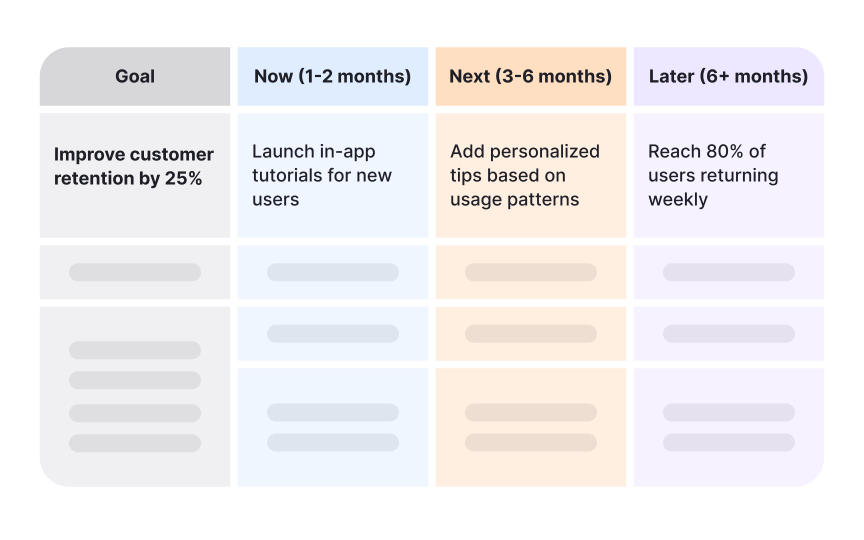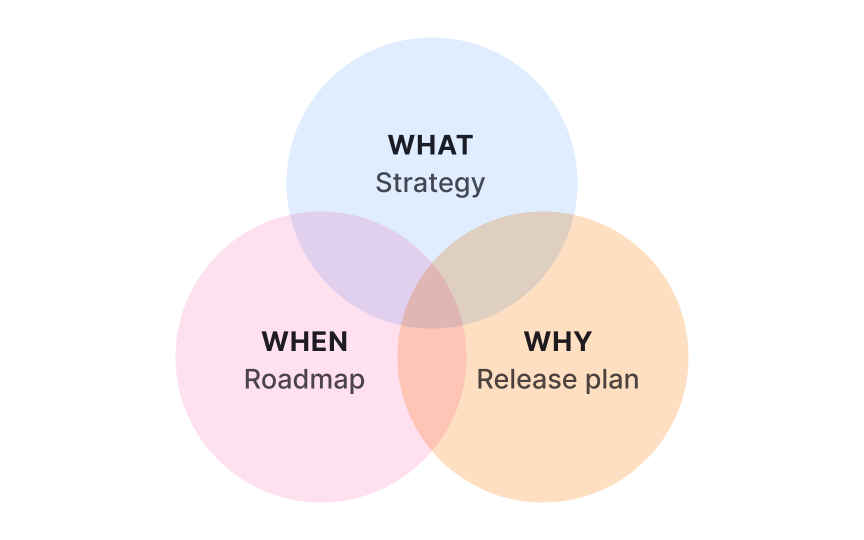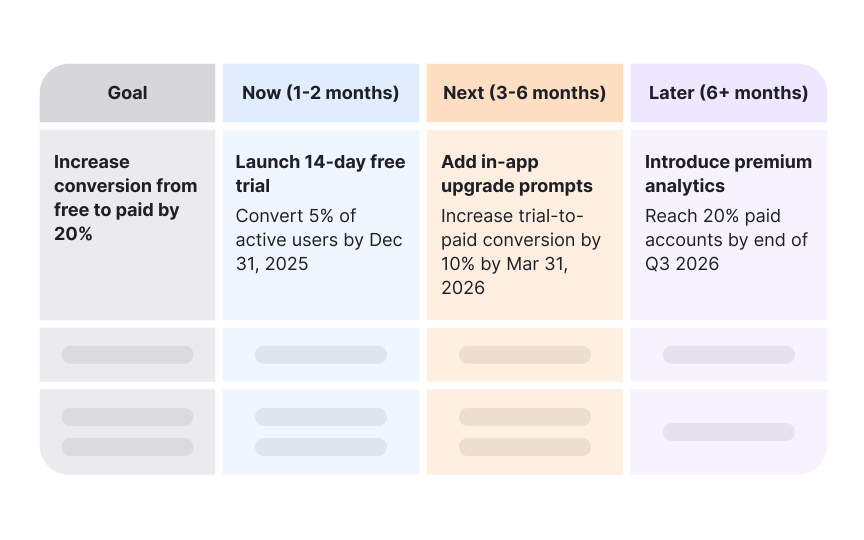From Strategy to Story
Build product roadmaps that connect strategy with outcomes through themes and storytelling.
A roadmap is more than a schedule of features. It is a story that shows where a product is heading, why it matters, and how every step supports broader goals. When strategy is translated into a clear narrative, it becomes easier for teams to stay aligned and for stakeholders to understand the direction.
Strong roadmaps replace long lists of tasks with themes and initiatives. Themes provide structure, linking day-to-day work with company objectives and user value. Instead of focusing only on outputs, they highlight outcomes and make it clear what impact the product aims to achieve.
This narrative perspective also helps tailor communication. Internal teams need to see dependencies and objectives, while external stakeholders want confidence that the product direction supports the market. A roadmap built as a story bridges these views, offering clarity, alignment, and shared purpose. It turns strategy into a living guide that motivates, informs, and inspires action.
A product roadmap is not a backlog or task list but a communication tool. It conveys the future direction of the product and shows how it may evolve over time. By presenting vision, priorities, and outcomes, it becomes a shared source of truth that aligns teams around intent rather than activity. Unlike static schedules, strong roadmaps highlight why
Because roadmaps communicate, they must adapt to audience needs. Executives often expect a broad view that links investment areas to company goals. Engineering and design teams benefit from visibility into initiatives, dependencies, and risks that guide daily planning. Sales and customer success require simplified versions that help them set realistic expectations with clients, while marketing looks for cues on timing to prepare campaigns. These tailored perspectives show the same direction through different lenses, preventing confusion and ensuring that every group sees how their work contributes to the bigger picture. This approach makes the roadmap a unifying tool for clarity, trust, and collaboration.[2]
Product strategy, the roadmap, and release plans are connected but serve different purposes. Product strategy defines the long term vision and the position the product aims to achieve in the market. It explains why the product exists, what problems it should solve, and which goals matter most. A roadmap translates this strategy into high level
Release plans then provide the near term detail needed for execution. They outline features, milestones, and dependencies across teams, often within a 30 to 90 day horizon. Confusing these layers creates risks. If a roadmap is treated as a release plan, stakeholders may misinterpret intent as fixed promises. If strategy is missing, the roadmap can devolve into a feature list without context. Keeping a clear line between why, what, and when preserves flexibility and helps teams act with both focus and adaptability.[3]
A roadmap that only reflects business objectives risks ignoring what users need. At the same time, a roadmap focused only on user requests can miss the larger picture of growth and sustainability. Effective roadmaps connect both perspectives, showing how solving customer problems contributes to business results. For example, reducing onboarding friction improves user satisfaction while also increasing activation rates, a metric tied to revenue.
This connection requires gathering insights from multiple sources. Customer feedback highlights pain points, while strategy defines the business outcomes that matter most, such as retention, expansion, or profitability. Roadmap
A roadmap that lists features with dates may look clear, but it hides the real story. Such lists resemble a
To avoid this trap, roadmaps should highlight themes,
Pro Tip: Before adding a feature, test if it communicates direction. If not, move it to the backlog.
A roadmap should not be a catalogue of features. Features describe isolated solutions, while themes and initiatives organize work around broader goals. A theme is a high level area of focus, such as
Defining themes begins with strategy. Ask which outcomes are critical for customers or the business, then group related features under these categories. Initiatives are then framed as the major bodies of work needed to achieve those outcomes. This structure shows how features connect to value and prevents the roadmap from being read as a
Pro Tip: Define themes by outcomes, then phrase initiatives as the big efforts that make those outcomes real.
Outputs describe what gets delivered, like a new dashboard or integration. Outcomes describe the effect those outputs create, such as faster
Defining outcomes requires clarity on metrics. These might include user adoption rates, churn reduction,
Roadmaps gain strength when themes are visibly tied to company strategy. Strategy outlines where the organization wants to compete and what goals matter most. Themes then serve as bridges, showing how product work contributes to these objectives. For instance, a company strategy of expanding into new markets might translate into themes such as “localization” or “regional integrations.” Each theme makes the
Defining this
Pro Tip: Write one line under each theme explaining which company goal it supports.
Not all stakeholders need the same view of the roadmap. Internal roadmaps are detailed, showing
External audiences can include customers, partners, investors, or advisory boards. Each group wants confidence in the product’s direction but not the full complexity of execution. Customers look for when new value will reach them, partners want to align their own plans, and investors expect to see how product growth supports business goals. Sharing too much detail with these audiences risks creating false certainty, but showing nothing reduces trust. Tailored external views build confidence while protecting flexibility and allowing internal teams to adjust as needed.
Roadmaps are not one-size-fits-all. Different types exist because audiences and contexts demand different ways of showing direction. Each type has strengths and risks, and knowing how they differ helps product teams avoid misunderstandings.
- Feature roadmap: Focuses on planned features and their expected delivery sequence. It helps engineering and design teams prepare but can mislead stakeholders if it looks like a commitment to exact dates. Without context, it may also reduce strategy to a checklist of outputs.
- Outcome-based roadmap: Organizes
initiatives under themes tied to measurable goals such as improvingretention , loweringchurn , or expanding into new markets. It helps executives and cross-functional teams see the impact of product work, shifting attention from “what will we build” to “what will change.” - Agile roadmap: Uses shorter planning cycles and adapts quickly when priorities or feedback change. It is best suited for delivery teams who need to align their work with strategy but cannot rely on long-term certainty. Its strength lies in flexibility, but this also means it offers less reassurance for audiences who expect stable commitments.
- Now-Next-Later roadmap: Groups initiatives by time horizons instead of fixed dates. “Now” shows what is being worked on, “Next” highlights what is coming soon, and “Later” signals long-term intent. It is often the best choice for customers and partners because it gives clarity of direction without over-promising timelines.
A roadmap becomes more powerful when it is presented as a story rather than a static
One way to craft this narrative is to introduce a starting point, highlight the problems or opportunities being addressed, and then describe the direction ahead in stages. Phrasing initiatives as parts of this journey makes them more relatable for both teams and stakeholders. For example, the roadmap might describe how early efforts lay the foundation for later growth. When structured as a story, the roadmap is not only a planning tool but also a way of inspiring confidence and alignment across audiences.
Even well-built roadmaps can drift from strategy if connections are unclear. Alignment gaps appear when initiatives are listed without showing which user problems they address or which business goals they support. They also appear when different versions of the roadmap tell conflicting stories to teams, executives, or customers. These gaps reduce trust and may cause wasted effort if teams chase features that are not tied to outcomes.
Spotting such gaps requires asking simple but critical questions. Can each
References
- Product Roadmaps are NOT Todo Lists — Ant Murphy | Ant Murphy
- Roadmap Is Not About Features - Productfolio | Productfolio
Top contributors
Topics
From Course
Share
Similar lessons

Roadmaps and Prioritization

Why You Need a Roadmap
























